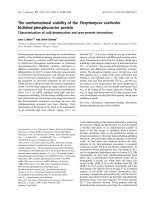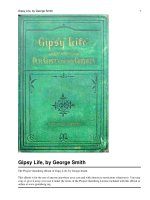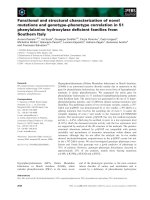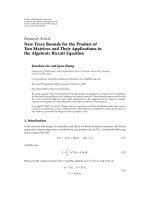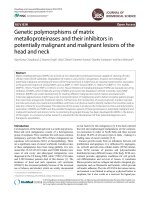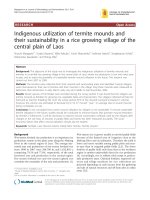Characterization of toxins in the culture supernatants of Clostridium Difficile and their immunogenic potential in mice
Bạn đang xem bản rút gọn của tài liệu. Xem và tải ngay bản đầy đủ của tài liệu tại đây (351.03 KB, 10 trang )
Int.J.Curr.Microbiol.App.Sci (2019) 8(5): 715-724
International Journal of Current Microbiology and Applied Sciences
ISSN: 2319-7706 Volume 8 Number 05 (2019)
Journal homepage:
Original Research Article
/>
Characterization of Toxins in the Culture Supernatants of
Clostridium difficile and their Immunogenic Potential in Mice
Parishmita Hazarika1, Rajeev K. Sharma1, Girindra K. Saikia1, Durlav P. Bora1*,
Luit M. Borkalita2, Sophia M. Gogoi1, Nirab K. Deuri2 and Ritam Hazarika2
1
Department of Microbiology, 2Department of Animal Biotechnology, College of Veterinary
Science, Assam Agricultural University, Khanapara Campus, Guwahati, Pin 781022,
Assam, India
*Corresponding author
ABSTRACT
Keywords
Clostridium difficile
tcdA, tcdB
Toxins
Immunogenic
Potential in Mice
Article Info
Accepted:
10 April 2019
Available Online:
10 May 2019
The Clostridium difficile toxins, toxin A and Toxin B were characterised in respect to the
influence of glucose and incubation period on release of toxins, cytotoxic activities of the
toxins in Verocell line and the immunogenic potential of C. difficile toxoids. A gradual
increase in protein concentrations was observed in the cell free supernatants of toxin A and
B positive C. difficile isolate with increase in incubation period and found to reach the
highest at 48 hr of incubation, i.e., 5.24 µg/µl and 5.06 µg/µl, respectively. Release of C.
difficile toxins in the culture supernatants was suppressed by glucose supplement in the
nutrient media. Both the partially purified toxins were found to be cytotoxic for vero cells
at both 1:10 and 1:100 dilutions. Cytotoxic activity of toxin B was more prominent than
toxins A. However, similar immune-protective efficacy (100.0%) was exhibited by both
the toxoid preparations (Toxoid A and B) in immunized animals against homologous
challenge with 6.0x108 CFU, while 75.0 percent protection against 9.0x108 CFU of
homologous strains of C. difficile was observed in both the groups, immunized separately
with toxoid A and B. The affected mice, following challenge with 9.0x10 8 CFU dose could
show clinical symptoms, suggestive of intestinal disorder, without mortality. However, all
the mice of control group died on 48 hr of post challenge with both 6.0 x 10 8 and
9.0x108CFU / dose of homologous strain of C. difficile.
disease condition in human, commonly
known as antimicrobial-associated diarrhea.
The organism produces several virulence
factors including toxin A (tcdA), toxin B
(tcdB), tissue degrading enzymes (proteases,
collagenase,
hyaluronidase,
heparinase
chondroitin-4-sulfatase), binary toxins, A
(cdtA) and B (cdtA), endospores, surface
Introduction
Clostridium difficile, the anaerobic, sporeforming, Gram-positive bacillus was first
identified in 1935 from the healthy newborns
(Hall and TO’Toole, 1935). The organism is
recognised as the most common nosocomial
pathogen responsible for a most important
715
Int.J.Curr.Microbiol.App.Sci (2019) 8(5): 715-724
layer proteins and fimbriae (Borriello, 1998;
Seddon and Borriello, 1992). The pathogenic
mechanism of the C. difficile isolates entirely
depends upon the optimum in vivo release of
toxins and their biological activities. The
releases of both the toxins are reported to be
growth phage dependent (Hundsberger et al.,
1997). Various environmental and physiochemical factors are also reported to have an
influence on the optimum release of C.
difficile toxin in the environment. Production
of C. difficile toxins was reported to be more
during the late logarithm growth phase and
the stationary phase (Ketley et al., 1986 and
Kamiya et al., 1992). Limiting nutrient levels
(e.g. glucose, amino acids, biotin), results in
up regulation of toxin expression (Dupuy and
Sonenshein, 1998; Haslam et al., 1986;
Karlsson et al., 1999, 2000; Yamakawa et al.,
1994, 1996). Toxin A of C.difficile is
primarily an enterotoxin and causes
hemorrhage and fluid secretion, while toxin B
is lethal and cytotoxic for most cell lines.
Considering
the
probable
zoonotics
importance of C. difficile, there is a growing
interest in prevention and in the development
of non-antibiotic based approaches to manage
C. difficile associated disease (Salnikova et
al., 2007). Toxoids A and B appears as a
promising approach to prevent CDAD and to
control recurrences (Giannasca and Warny,
2004; Sougioultzis et al., 2005). Considering
the importance of C. difficile toxins in disease
production and control, the present study was
undertaken to determine the influence of
growth and nutritional factors on the release
of the toxin and to determine cytotoxic
activities of C. difficile toxins in Vero cells as
well as the immune-protective potential of
partially purified toxoids in mice.
selected from the repository of Department of
Microbiology, College of veterinary science,
Assam Agricultural University, Khanapara,
Guwahati -22, Assam. The pig isolates were
positive for tox A gene, while tox B was
detected in the dog isolates.
Influence of glucose and incubation hour
on release of C. difficile and toxins
The influence of glucose in the growth media
and influence of incubation period on in-vitro
release of C. difficile toxins were studied as
per method of Rolfe and Finegold (1979). A
few pure isolated colonies of two randomly
selected tcdA and tcdB gene positive isolates
C. difficile isolates from CycloserineCefoxitin-Fructose Agar (CCFA) plates were
inoculated separately into 30.0 ml Brain Heart
Infusion (BHI) broth and incubated
anaerobically for overnight at 37oC.The
overnight broth cultures were centrifuge at
6000 rpm for 10 minutes. The pellets from the
respective tubes were re-suspended separately
in 5.0 ml of Phosphate Buffered saline (PBS).
A fixed volume (2.0 ml) of each suspension
was transferred to a set of fresh tubes,
containing 30.0 ml of thioglycolate broth with
glucose and without Glucose. Following
incubation anaerobically for 48 hr, a 5.0 ml of
broth culture from each tube was periodically
removed at 8, 12, 24 and 48 hr and the purity
of growth were checked. Supernatants were
collected from the respective broth cultures
by centrifugation at 16,000 rpm for 30 min.
Culture supernatants, extracted at different
incubation period and in different nutrient
environment were partially purified by
ammonium sulphate precipitation technique at
70.0 percent saturation, as described by
Mahony et al., (1989). Partially purified
culture supernatants were screened for protein
concentrations, following the method of
Lowry et al., (1951). The partially purified
culture supernatants of C. difficile were also
screened for release of toxins by a
Materials and Methods
Clostridium difficile strains
Six toxigenic field isolates of Clostridium
difficile, Pig and Dog origin were randomly
716
Int.J.Curr.Microbiol.App.Sci (2019) 8(5): 715-724
commercial rapid membrane immune assay
kit (TechLab, USA).
Preparation of
detoxified toxins
Cytotoxic activities of the partially purified
C. difficile toxins
Both the partially purified toxins of C.
difficile were detoxified with formaldehyde
for production of toxoids, as per the
procedure of Kelly et al., (1995).
Detoxification was done by addition of 2.8 µl
of formaldehyde (37.0%) to each of the 100
µl of partially purified toxins and Incubation
at 37oC. After 2 hr of incubation, the excess
formaldehyde was removed by dialysis
against NSS for 1 hr. The dialyzed detoxified
toxins were filter sterilized by passing
through 2 µm Millipore filter. Complete
detoxifications of the toxins were tested in
Vero cell line with two different dilution
(1:10 and 1:100), as described above.
The partially purified toxins (toxin A and
Toxin B) of C. difficile strains were screened
for cytotoxic activities on Vero cells,
maintained in the Department of Veterinary
Microbiology, College of Veterinary Science,
Khanapara, Guwahati, Assam.
Both the partially purified toxins were
prepared from the growth of respective isolate
in suitable thioglycolate broth and incubation
period, determined earlier were filtered
through 0.20 µm membrane filter (Millipore,
India). Two levels of serial dilution (1:10 and
1:100) were made from each partially purified
toxins in PBS and 100 µl of respective diluted
toxin was transferred to six wells of 12 well
tissue culture plate (Nunc, Denmark) with 24
hr confluent growth of monolayer of Vero
cell, while the remaining three wells were
kept as negative control with addition of 100
µl of PBS.
toxoid
vaccine
from
Vaccine preparations were made from each of
the detoxified toxin of C. difficile, by mixing
with Freund's (complete and incomplete)
adjuvant (Sigma, USA) to give a final protein
conc. of 15 µg /ml (Anosova et al., 2013).
Immunization trial
Two groups (A & B) of mice, consisting of
six animals of same weight, age and sex, in
each group were immunized with 0.2 ml of
Freund's complete adjuvanted detoxified toxin
A and B (15 µg/ml protein) through intramuscular (i/m), respectively (Anosova et al.,
2013). Another group of six mice (Gr. C) of
same weight, age and sex was injected with
0.2 ml of NSS i/mly and kept as control. All
the mice, including the control group were
bled before immunization (0 day) for preimmunized serum. Animals of both the
vaccinated groups were boosted on 14th day of
primary immunization with 0.2 ml of
respective toxoid vaccine with Freund's
incomplete adjuvant, with same protein
concentration and route. Mice of all the three
groups were observed till 34th day of primary
immunization.
Inoculated tissue culture plate was incubated
at 37oC in CO2 incubator with addition of
maintenance media (EMEM, Hyclone). All
the test wells, including the negative control
wells were observed from 18 hr of incubation
till 48 hr for cytopathic changes in the cells,
viz., rounding of cells, detachment of monolayers etc., if any.
Immuno-protective potential of C. difficile
toxoids in mice
Immuno protective efficacy of the toxoids,
prepared from respective toxins (A and B)
was carried out in groups of mice with a prior
approval from the Institutional Animal Ethics
Committee, College of Veterinary Science,
Assam Agricultural University, Khanapara,
Guwahati, Assam.
717
Int.J.Curr.Microbiol.App.Sci (2019) 8(5): 715-724
be increasing in culture supernatants of
thioglycolate broth, with or without glucose
supplement, and with increase incubation
period. Detail results were depicted in Table
1. The culture supernatants of the toxA
positive C. difficile, grown in conventional
thioglycolate
broth
without
glucose
supplement for initial 8hrs, exhibited protein
conc. of 1.43 µg/µl. Almost similar conc. of
protein (1.40 µg/µl) could be detected in
culture supernatant of the same isolate, while
grown in presence of glucose supplement.
Increase in incubation period could reveal a
gradual increase in the protein conc. in the
culture free supernatant of toxin A positive C.
difficile, grown in presence or absence of
glucose. However, the same isolate grown in
thioglycolate broth without supplementation
of glucose could exhibit a protein conc.
(5.24µg/µl) in the culture supernatant at 48hr
of incubation. On the other hand, the addition
of glucose could show a comparatively low
conc. of protein (3.49 µg/µl), released by the
same C. difficile isolate in the culture
supernatant at 48 hr. of incubation. Similar
trend was also observed in respect to the
protein conc. in the culture supernatant of
toxB positive C. difficile in thioglycolate
broth, with or without glucose, and increase in
incubation period. The protein concentration
in the cell free supernatant of toxin B
producing C. difficile isolates under the
influence of glucose was found to be 1.94
µg/µl at 8 hr of incubation, while absence of
glucose in the nutrient medium revealed a
protein conc. of 1.28 µg/µl at the same period
of incubation. However, 48 hr. of incubation
of toxB positive C. difficile growth in
thioglycolate broth without glucose could
exhibit protein conc. of 5.06 µg/µl. which was
found to be apparently more than that
revealed by the growth of the same isolate
with glucose supplement (3.99 µg/µl).
Challenged trial
The challenge inoculums were prepared
separately from overnight growth of pure
colonies of respective toxin gene positive C.
difficile strains anaerobically in 5 ml BHI
broth. Collected pellets after centrifugation
were washed three times with sterile NSS and
the respective washed bacterial pellets were
re-suspended in duplicate tubes with
sufficient volume of sterile NSS solution to
get final concentration of 6.0 × 108 CFU
(MacFarland tube no.1) and 9.0 × 108 CFU
per ml (Mac Farland tube no.2).
Animals of all the three groups (A-C) were
pretreated with 0.2ml of clindamycin
injection with a final concentration of 10
mg/kg through intra-peritoneal (i/p) route on
34th day of primary immunization. Half of the
pretreated mice of groups, A1 and B1 were
challenged intra-gastrically (i/g) with 0.2 ml
of 6.0 x 108 CFU of respective homogenous
strain of C. difficile live culture, while the
other half (A2 and B2) were challenged with
9.0 x 108 CFU of respective live culture.
Equal no. of mice of the control groups (C1
and C2) were also challenged with 9.0 x 108
CFU of live strain of toxin A and B positive
C. difficile. All the challenged mice were
observed up to 48 hr post challenge for
mortality and gross changes, if any.
The mice died within 48 hr of challenge were
examined for any pathological changes in the
visceral organ and digestive tract. Reisolation of inoculated C. difficile was
attempted from the internal organs of the mice
died during challenged trial.
Results and Discussion
Influence of glucose and incubation period
on release of C. difficile toxins
Screening of culture supernatants for release
of C. difficile toxins, A and B by the
commercial kit could reveal sharp prominent
The release of C. difficile (toxA and toxB)
toxins, in terms of protein conc. was found to
718
Int.J.Curr.Microbiol.App.Sci (2019) 8(5): 715-724
bands in respective position for C. difficile
specific Glutamate Dehydrgenase (GDH)
protein and toxins (Fig. 1).
faeces, within 24 hr of challenge with
9.0x108CFU/ dose of homologous challenge
(Fig. 3). The clinical symptoms were found to
be subsided on 48 hrs of observation. Fifty
percent of mice vaccinated with toxoid,
prepared from toxin B positive isolate showed
clinical symptoms within 24 hrs of
homologous challenge with a dose of
9.0x108CFU. All the clinically affected mice
were succumbed to death on 48hr of
challenge. The challenge infection with 6.0
x108 CFU and 9.0x108CFU / dose in the mice
of control group (D1 and D2) revealed an
initial development of clinical symptoms
during 24 hr of observation, suggesting
intestinal infection. All the clinically affected
mice of control groups were died within 48 hr
of observation.
Cytotoxic activities of the partially purified
C.difficile toxins
The partially purified culture supernatants of
toxA and toxB bearing C. difficile strains
growth under favourable nutrient environment
and incubation period revealed cytotoxic
changes in vero cell line. The vero cells
treated with the dilutions, 1:10 (4.20mg/ml)
and 1:100 (0.42mg/ml) of toxA positive
isolate could show detachment, rounding,
clumping and reduction in cell count. The
visible cytopathic effects (CPE) was observed
within 18-24 hr and lasted for 48hr of
incubation. The partially purified culture
supernatant of toxin B positive C. difficile
also exhibited similar cytotoxic activities in
vero cell line at both 1:10 and 1:100 dilutions
(Fig. 2). However, the changes in vero cell
produced by toxB were found to be more
distinct at lower protein conc. (2.20mg/ml),
while CPE was observed in treated vero cells
with 4.20mg/ml protein conc. in toxA positive
C. difficile culture supernatant.
Post mortem of the dead mice from the
control group revealed hemorrhage in the
intestinal mucosa with gas bubbles and fragile
liver (Fig. 3). Detection of C. difficile, based
on presence of gluD gene from the affected
liver as well as from the intestinal piece and
contents of dead mice confirmed the mortality
due to injected C. difficile isolates
Influence of glucose and incubation period
on release of C. difficile toxins
Immuno-protective potential of C. difficile
toxoid vaccines
The present study could reveal a negative
impact of glucose on protein conc. in the cell
free supernatants of toxA and toxB positive C.
difficile isolate. Protein conc. in the cell free
supernatant of toxA bearing C. difficile in
thioglycolate broth with glucose supplement
was found to be 1.40 µg/ml at 8hr of
incubation, while 8 hr growth of the same
isolate in thioglycolate medium without
addition of glucose revealed almost same
protein conc. (1.43 µg/ml) in culture
supernatant. Although there was an increasing
trend in the protein conc. with increase in
incubation period, till 48hr of observation, the
toxA positive isolate in thioglycolate broth
The immuno-protective efficacy of the toxoid,
prepared from the culture supernatants of both
toxA and toxB positive isolates of C. difficile
could reveal variable protection level in mice,
during 48hr of observation (Table 2).
Both the toxoid preparations could confer 100
percent protection to groups of mice (A1 and
B1) against 6.0x108CFU dose of homologous
challenge, till 48 hr of observation. On the
other hand, 25.0 percent of the immunized
mice (A2) with toxoid preparation of toxin A
positive isolate showed clinical symptoms of
ruffle coat with static movement with loose
719
Int.J.Curr.Microbiol.App.Sci (2019) 8(5): 715-724
without glucose supplement could show
higher protein conc. (5.24 µg/ml) than the
thioglycolate broth culture without addition of
glucose at 48hr of incubation (3.49 µg/ml).
Almost similar trend in protein conc. was
revealed by the tox B positive isolate, grown
in presence glucose with increasing period,
i.e. 8 hr (1.94 µg/ml) to 48hr (3.99 µg/ml),
while growth of the same isolate in
thioglycolate
broth
without
glucose
supplement showed 1.28 µg/ml and 5.06
µg/ml of protein at 8hr and 28hr of
incubation. Based on the present observation,
it could reveal that incubation period have a
positive impact on release of C. difficile toxin
in the culture supernatants, while glucose in
the nutritional environment was found to
inhibitory for release of C. difficile toxin in
the culture supernatants.
Cytotoxic activity of partially purified
toxins of C. difficile in vero cell line
Both tox A and tox B bearing C. difficile
isolates revealed cytotoxic changes, i.e.,
detachment,
rounding,
clumping
and
reduction in cell count in the treated vero
cells, within 18-24 hr of incubation. Among
the partially purified toxins, more prominent
CPA was exhibited by the toxinB positive C.
difficile isolate with comparatively low
protein conc. (2.20mg/ml) than toxin A
(4.20mg/ml) at 1:10 dilution. Many previous
studies also opined for Vero cell, as a wellestablished cell line for testing the cytotoxic
activities of C. difficile (Maniar et al., 1987).
However, Torres et al., (1992) could observe
variable CPE in different cell lines, exhibited
by toxin A and toxin B. More prominent
cytotoxic activity could be seen in human
colon carcinoma cells (HT-29, epithelial
cells) and rhesus monkey kidney cells (MA104, epithelial cells), exhibited by toxin A of
C. difficile, while Vero cell line was found to
be more suitable for toxin B of C. difficile.
Variability could be observed among different
strains of toxin B positive C. difficile, in
respect to the type of CPE produced in the
Vero cells (Borriello et al., 1992).
Comparatively more cytotoxic activity
exhibited by toxin B of C. difficile in Vero
cell line during the present study was in
agreement with the previous observation of
Lyras et al., (2009). They could provide
evidence that the toxin B was more essential
than toxin A for virulence. Kuehne et al.,
(2010) recorded more susceptibility of HT29
(human colon carcinoma) cells towards toxin
A, while the toxin B exhibited more
prominent cytotoxic activity in Vero cells.
Expression of toxins of C. difficile was
recorded, mainly during the late exponential
growth phase and the stationary phase
(Kamiya et al., 1992; Ketley et al., 1986).
Release of C. difficile toxins was also
recorded under limiting nutrient levels, e.g.
glucose, amino acids, biotin, which lead to
upregulation of toxin expression (Dupuy &
Sonenshein, 1998). Reports on protein profile
of C. difficile in cell free extract with different
environmental conditions was found to be
very scanty in the available literature.
Catabolite repression of toxin genes results in
reduction in release of C. difficile toxins.
Dupuy and Sonenshein (1998) revealed
catabolite repression of toxin genes of C
difficile by addition of glucose in the nutrient
medium. They could also observe the
repression of tox mRNA in C. difficile, during
exponential growth phase and more
prominent during in stationary phase with
addition of glucose. They also opined during
their study that the effect of glucose on
release of C. difficile toxins might be a
general mechanism for many toxigenic
isolates.
Immuno-protective potential of c. Difficile
toxoid vaccines
Variable protection level could be conferred
in immunized mice by the two toxoids
720
Int.J.Curr.Microbiol.App.Sci (2019) 8(5): 715-724
prepared separately from toxin A and toxin B
positive C. difficile isolates. Following
challenge on 34th day of post immunization
with 6x108 cfu of homologous C. difficile
strain, all the clindamycin pretreated mice
were protected. On the other hand, 25.0
percent of mice, immunized with toxoid A
could not withstand the challenge with higher
conc. (9x108 cfu) of the same homologous
isolate. Similarly, 50.0 percent of vaccinated
mice (toxoid B) showed clinical symptoms of
intestinal disorder within 24 hr of challenge
with a dose of 9x108 cfu of homologous
strain, followed by death on 48hr of
observation. The challenge infection with 6.0
x 108 and 9.0x108 CFU / dose in the mice of
control group revealed an initial development
of clinical symptoms of intestinal infection
during 24 hr of observation and all the
clinically affected mice were died within 48
hr of challenge.
Table.1 Protein concentration in the toxins released in nutrient media at different stages of
growth
Type of
isolates
ToxA+ve
ToxB+ve
Protein concentration (µg/µl) in the culture supernatants of
Thioglycolate broth with Glucose
Thioglycolate without Glucose
Incubation period
Incubation period
8 hr
12 hr
24 hr
48 hr
8 hr
12 hr
24 hr
48 hr
1.40
2.81
3.12
3.49
1.43
3.65
4.08
5.24
1.94
2.67
3.03
3.99
1.28
2.33
3.6l
5.06
Table.2 Protective efficacy of C. difficile toxoid in vaccinated mice
Type of toxoid
Gr.
No. of
Animal
Toxoid A
A1
A2
B1
B2
D1
4
4
4
4
4
Toxoid B
Control
No. of Vaccinated mice affected following Challenge
Clostridium difficile (6 x 108 cfu)
Clostridium difficile (9 x 108 cfu)
≥24 hr
48 hr
≥24 hr
48 hr
Clinical Death Clinical Death Clinical Death Clinical Death
change
change
change
change
----1 (25)
-------2 (50)
--2(50)
4 (100)
--4(100) 4 (100)
--4(100)
Figures in parenthesis indicate percentages
Fig.1 Rapid membrane immune assay (TechLab, USA) for detection of C. difficile and toxins
721
Int.J.Curr.Microbiol.App.Sci (2019) 8(5): 715-724
Fig.2 Cytotoxic activity of partially purified toxin in the culture supernatant of C. difficile in
monolayer of Vero cell
(A) Normal spindle shaped cells in monolayer of Vero cell line.
(B) Rounding and reduction in cell count and in vero cell line treated with partially purified toxin (1:10).
(C) Rounding and reduction in cell count and in vero cell line treated with partially purified toxin (1:100)
Fig.3 Mouse showing clinical symptoms following challenge with C. difficile
(A) Clinically affected mouse with loose faeces (arrow head) during 24 hr of challenge
(B) Hemorrhage with gas formation (arrow head) in the affected intestine of dead mouse
(C) Enlarged fragile Liver ( arrow headed) of the dead mouse following challenge
Torres et al., (1995), in their study could
provide evidence of protection conferred by
vaccination with C. difficile toxoids (A+B)
against challenge with 105 cfu of viable C.
difficile. However, they also opined for an
appropriate immunization regimen for an
effective immunogenic potential. The route of
antigen administration was reported to be an
important determinant of mucosal immune
effector function. The intragastric and rectal
routes of immunization were recorded to be
ineffective. They recorded a combination of
mucosal and parenteral immunization with C.
difficile toxoid to be the most effective
regimen of immunization for induction of
protective immunity against C. difficile
disease. They also opined for clindamycin
treatment before challenge trial, which was
found to have an influence on colonization of
C. difficile strain. In a similar study, Siddiqui
et al., (2012) could confirm 100 percent
protection in hamsters conferred by the
formaldehyde treated C. difficile toxin against
homologous challenge with 106 spores.
Based on the present observation with support
of previous studies, it can be concluded that
the formaldehyde treated toxoids of C.
722
Int.J.Curr.Microbiol.App.Sci (2019) 8(5): 715-724
Microbiol., 21: 293-297.
Hundsberger, T., Braun, V., Weidmann, M.,
Leukel, P., Sauerborn, M. and von Eichel
Streiber, C. (1997). Transcription analysis
of the genes tcdA-E of the Pathogenicity
locus of Clostridium diffiile. Eur. J.
Biochem., 244: 735-742.
Kamiya, S., Ogura, H., Meng, X.Q. and
Nakamura, S. (1992). Correlation between
cytotoxin production and sporulation in
Clostridium difficile. J. Med. Microbiol.,
37: 206-210.
Karlsson, S., Burman, L. G. and Akerlund, T.
(1999). Suppression of toxin production in
Clostridium difficile VPI 10463 by amino
acids. Vet. Microbiol., 145: 1683-1693.
Karlsson, S., Lindberg, A., Norin, E., Burman,
L. G. and AIkerlund, T. (2000). Toxins,
butyric acid and other short chain fatty
acids are co-coordinately expressed and
down regulated by cysteine in Clostridium
difficile. Infect. Immun., 68: 5881-5888.
Ketley, J. M., Mitchell, T. J., Haslam, S. C.,
Stephen, J., Candy, D.C.A. and Burdon, D.
W. (1986). Sporogenesis and toxin A
production by Clostridiun difficile. J. Med.
Microbiol., 22: 33-38.
Kelly, C. P., Pathoulakis,C., and LaMont, J. T.
(1995). Clostridium difficile colitis. N.
Engl. J.Med., 330: 257-262.
Kuehne, S. A., Cartman, S. T., Heap, J. T.,
Kelly, M. L., Cockayne, A. and Minton, N.
P. (2010). The role of toxin A and B in
Clostridium difficile infection. Nature, 467:
711-714.
Libby, J. M., Jortner, B. S. and Wilkins, T.D.
(1982). Effects of the two toxins of
Clostridium
difficile
in
antibioticassociated cecitis in hamsters. Infect.
Immun., 36: 822-829.
Leuzzi, R., Spencer, J., Buckley, A., Brettoni,
C., Martinelli, M., Tulli, L., Marchi, S.,
Luzzi, E., Irvine, J. and Candlish, D.
(2014). Protective efficacy induced by
recombinant Clostridium difficile toxin
fragments. Infect. Immun., 81: 2851-60.
Lyras, D., Connor O’, J. R., Howarth, P. M.,
Sambol, S. P., Carter, G. P., Phumoonna,
T., Poon, V. R., Adams, G. V., Johnson, S.,
difficile can be used as suitable immunogen
for control of C. difficile infection in
individuals.
However, to ascertain its protective efficacy
against hetrologous challenge with live
bacteria and bacterial toxin, a further study
has to be carried out with computation of the
dose, protein conc. and selection of a suitable
route of immunization.
References
Anosova, N. G., Brown, A. M., Li, L., Liu, N.,
Cole, L. E., Zhang, J., Mehta, H. and
Kleanthous, H. (2013). Systemic antibody
responses induced by a two-component
Clostridium difficile toxoid vaccine protect
against C. difficile associated disease in
hamsters. J. Med. Microbiol., 62: 1394-404.
Borriello, S.P. (1998). Pathogenesis of
Clostridium
difficile
infection.
J.
Antimicrob. Chemother. 41: 13-19
Borriello, S.P., Wren, B.W., Hyde, S., Seddon,
S.V., Sibbons, P., Krishna, M. M.,
Tabaqchali, S., Manek, S. and Price, A. B.
(1992). Molecular, immunological and
biological characterization of a toxin Anegative, toxin B-positive strain of
Clostridium difficile. Infect. Immun., 60:
4192-4199.
Dupuy, B. and Sonenshein, A. L. (1998).
Regulated transcription of Clostridium
difficile toxin genes. Mol. Microbiol.,
27:107-120.
Giannasca, P.J. and Warny, M. (2004). Active
and
passive
immunization
against
Clostridium difficile diarrhea and colitis.
Vaccine. 22 (7): 848–856.
Hall, I. C. and O’Toole, E. (1935). Intestinal
flora in new-born infants with a description
of a new Pathogenic anaerobe, Bacillus
difficile. Am. J. Dis. Child., 49: 390-402.
Haslam, S. C., Ketley, J. M., Mitchell, T. J.,
Stephen, J., Burdon, D. W. and Candy, D.
C. (1986). Growth of Clostridium difficile
and production of toxins A and B in
complex and defined media. J. Med.
723
Int.J.Curr.Microbiol.App.Sci (2019) 8(5): 715-724
Gerding, D. N. and Rood, J. I. (2009).
Toxin B is essential for virulence of
Clostridium difficile. Nature, 458: 11761179.
Mahony, D. E., Gilliatt, E., Dawson, S.,
Stockdale, E. and Lee, S. H. S. (1989).
Vero cell assay for rapid detection of C.
perfringens enterotoxins. Appl. Environ.
Microbiol., 55(9): 2141-2143.
Maniar, A. C., Williums, T. W. and Hammond,
G. W. (1987). Detection of Clostridium
difficile toxin in various tissue culture
monolayers. J. Clin. Microbiol., 25: 19992000.
Rolfe, R. D. and Finegold, S. M.
(1979).Purification and Characterization of
Clostridium
difficile
Toxin.
Infect.
Immune., 25: 191-201.
Salnikova, M. S., Joshi, S. B., Rytting, J. H.,
Warny, M. and Middaugh, C. R. (2007).
Physical Characterization of Clostridium
difficile Toxins and Toxoids: Effect of the
formaldehyde Crosslinking on Thermal
Stability. J. Pharmaceutical. Sci., 97(9):
3735-3752.
Seddon, S. V. and Borriello, S. P. (1992).
Proteolytic activity of Clostridium difficile.
J. Med. Microbiol., 36(5): 307-311.
Siddiqui, F., O’Connor, J. P., Nagaro, K., C,
Adam., Sambol, S. P., Vedantam, G.,
Gerding, D.N. and Johnson, S. (2012).
Vaccination with parenteral toxoid B
protects hamsters against lethal challenge
with toxin A-negative, toxin B-positive
Clostridium difficile but does not prevent
colonization. J. Infect. Dis., 205: 128-133.
Sougioultzis, S., Kyne, L., Drudy, D., Keates,
S., Maroo, S., Pothoulakis, C., Giannasca,
P.J., Lee, C.K., Warny, M., Monath, T.P.
and Kelly, C.P. (2005). Clostridium difficile
toxoid vaccine in recurrent C. difficileassociated diarrhea. Gastroenterology, 128:
764-770.
Toma, C., Nakamura, S., Kamiya, S., Nakasone,
N. and lwanaga, M. (1999). Detection of
Clostridium difficile Toxin A by Reversed
Passive Latex Agglutination. Microbiol.
Immunol., 43(8): 737-742.
Torres, J. F., Lyerly, D. M., Hill, J. E., Monath,
T. P. (1995). Evaluation of formalininactivated Clostridium difficile vaccines
administered by parenteral and mucosal
routes of immunization in hamsters. Infect.
Immun., 63: 4619-4627.
Torres, J., Camorlinga, P. M. and Munoz, O.
(1992). Sensitivity in culture of epithelial
cells from rhesus monkey kidney and
human colon carcinoma to toxins A and B
from Clostridium difficile. Toxicon, 30: (4)
419-426.
Wang, B., Wang, S., Rustaind, R. R., Wang, F.,
Mensch, C. D., Hong, L., Kristopeit,A.,
Secore, S., Dornadula, G., Kanavage, A.,
Heinrichs, J. H., Mach, H., Blue, J. T. and
Thiriot, D. S. (2015). Detecting and
preventing reversion to toxicity for a
formaldehyde- treated C. difficile toxin B
mutant. Vaccine, 33: 252-259.
Yamakawa, K., Kamiya, S., Meng, X. Q.,
Karasawa, T. and Nakamura, S. (1994).
Toxin production by Clostridium difficile in
a defined medium with limited amino acids.
J. Med. Microbiol., 41: 319-323.
Yamakawa, K., Karasawa, T., Ikoma, S. and
Nakamura, S. (1996). Enhancement of
Clostridium difficile toxin production in
biotin limited conditions. J. Med.
Microbiol., 44: 111-114.
How to cite this article:
Parishmita Hazarika, Rajeev K. Sharma, Girindra K. Saikia, Durlav P. Bora, Luit M. Borkalita,
Sophia M. Gogoi, Nirab K. Deuri and Ritam Hazarika. 2019. Characterization of Toxins in the
Culture Supernatants of Clostridium difficile and their Immunogenic Potential in Mice.
Int.J.Curr.Microbiol.App.Sci. 8(05): 715-724. doi: />
724
